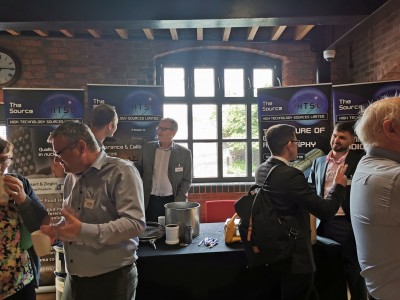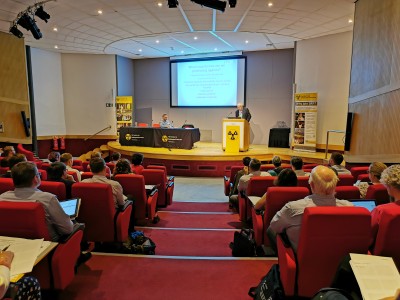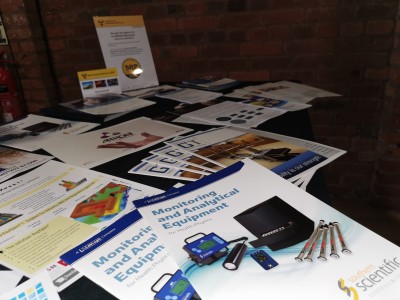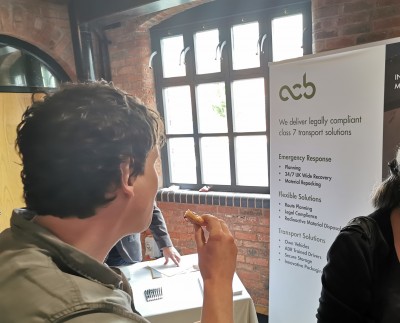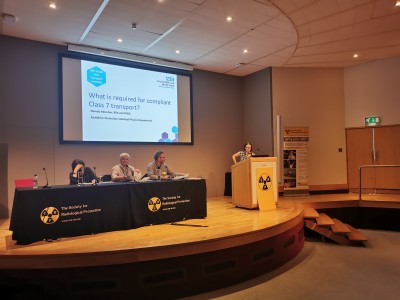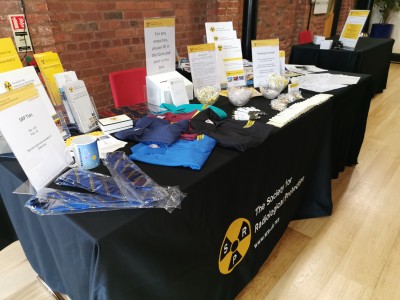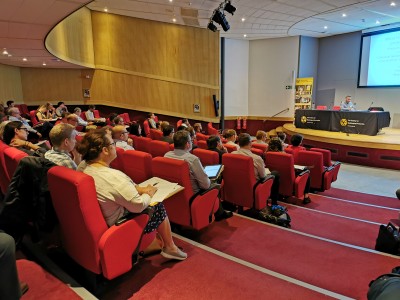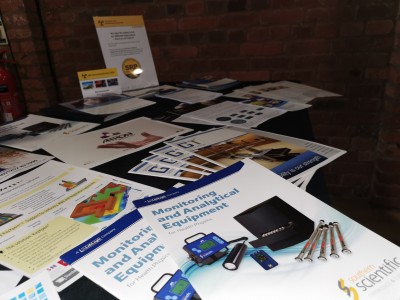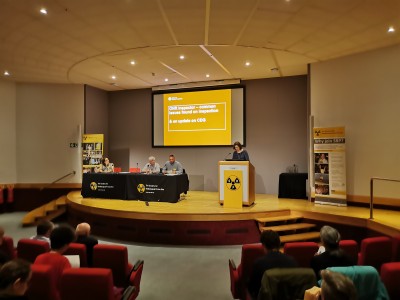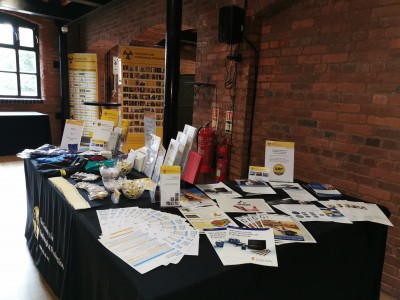Class 7 Transport for the Small User: Hospitals & Universities
19 June 2019
Austin Court, IET Birmingham
This was the first of two consecutive stand-alone one day meetings on different topics, a structure enabling some delegates to make the most of long and expensive travel. Dealing with a topical subject of great interest it was attended by over 70 delegates and six exhibitors.
Some re-ordering of the programme was necessary due to the unavoidable delay of one early speaker so the first presenter was Gary Holden of consultancy GVH Projects who began with an explanation of the difference between ‘exempt’ (radioactive material) and ‘excepted’ (packaging). He then considered the hierarchy of legislative documents from IAEA SSR-6 through ADR to CDG and of packaging from excepted to Type B. Gary also differentiated between ‘routine’ and ‘normal’ conditions of transport (they are quite different!) and gave a plug to the Transport Container Standardisation Committee and its codes of practice.
Jilly Croasdale, Head of Radiopharmacy Department at Sandwell and West Birmingham Hospitals NHS Trust is well qualified for the subject of her presentation ‘Preparing and receiving a class 7 ONR inspection’ having survived several dating back to the days of Department for Transport (DfT). She extolled the virtues and value of a radiological risk assessment covering both CDG and IRR 17 which, in even the best run of establishments, is likely to identify some remedial actions. Her ‘take home’ message to endeavour to be ‘inspection ready’ at all times was well made.
Lindsey Cairns replaced Mike Nettleton at short notice to relate ‘Common issues found on ONR inspections and an update on CDG’. Lindsey acknowledged that there is a lot of legislation relevant to the transport of radioactive material and that it can be quite complex. ONR enforces both CDG and IRR 17 with respect to transport which is more wide ranging than the definition of transport in IRR 17. It was pleasing to hear Lindsey report generally good compliance. ONR will typically request a radiological risk assessment a couple of weeks prior to an inspection and this is likely to be a key feature of the subsequent inspection. Lindsey gave brief case studies of two transport related incidents before moving on to the amendment of CDG and the consultation on associated guidance (see SRP weekly dated 12 June 2019) to which delegates were encouraged to respond. With respect to radiation emergencies involving the transport of radioactive materials Lindsey identified a widespread misunderstanding of the performance of Type A packages in a severe accident such as a fire. A new requirement in 2020 will be an obligation to report the outcome of a test of emergency response plans to ONR with a plea to stagger such tests in order to avoid a deluge to ONR immediately post implementation.
Gary Spooner, an independent DGSA, considered the role of the DGSA in ADR (D’Accord Dangereux Routier) or the European agreement concerning the international carriage of dangerous goods by road (which at least explains why it is always abbreviated to ADR). In UK ADR requirements find their way into CDG but there are some, minor, differences. He then, usefully, spent some time explaining the requirements table in ADR covering over 3,500 dangerous goods and identifying the radioactive ones. There was subsequent discussion about requirements for transport through tunnels and the possible use of motorcycle couriers to carry short half life pharmaceuticals. ADR applies to vehicles with four or more wheels whilst CDG to those with two or more.
Mandy Moreton, RPA and RWA at Colchester Hospital considered the duties and obligations of a consignor of radioactive materials focussing on her area of healthcare which can involve complex multi-stage processes. She emphasised the need to document all aspects of the management system and to ensure that all certification relating to sources and containers is within its period of validity. She showed some useful examples of documents from her workplace including emergency instructions for drivers and for the receipt of radioactive material by security staff outside normal working hours.
Marcus Howell of Alliance Medical Radiopharmacy Ltd. differentiated between a carrier (collect, take to a central point and deliver from there) and a courier (point to point direct collection and delivery) with each being appropriate for different types of radioactive material transport. His company predominantly uses couriers for their 18,000 deliveries per year of time critical short half life PET isotopes. He then considered the duty of care of a consignor to understand the courier’s (or carrier’s) driver training, vehicle maintenance etc. and how he undertook random checks on them. The use of vehicles equipped with GPS tracking enables accurate estimates of delivery times in addition to enhanced security information.
George Sallit, latterly of DfT and ONR (Transport) began with the IAEA definition of a radiation protection programme before looking, in detail, at what it should include for an operation involving the transport of radiophamaceuticals.
Tracy Soanes from Royal Hallamshire Hospital in Sheffield addressed security in transport by road, a subject in which she has considerable experience. She reminded the audience that both physical and information security must be considered and that everyone within an organisation has a shared responsibility for security. Tracy recommended ONR’s internal guidance to inspectors and DfT’s security risk assessment templates together with their training video titled ‘Lockdown’. She then considered some real life and potential vulnerabilities and how they may be controlled.
Martin Porter from Sellafield spoke here on behalf of Radioactive Materials Transport Users Committee (RAMTUC) of which he is currently Chair and Director. As incidents involving radioactive materials, even minor ones, are likely to attract significant interest attention to detailed and effective emergency planning is vital.
The final presentation of the day, for which almost the entire audience chose to remain, was given by Jennifer Povenda from Nottingham university Hospitals on the subject of Transport incidents and lessons learned. She considered the number and nature of incidents reported periodically by the then HPA-CRCE before looking at two examples from her personal experience identifying both immediate, underlying and root causes. Her final lesson learned, echoing some earlier speakers, related to the rehearsal of contingency plans.
The meeting consisted of a well thought out programme with some excellent presentations. It was, overall, very useful and informative.
The presentations from the day can be found below (you must be logged into MySRP to view them).
The role of a DGSA and navigating through ADR & the regulations - Gary Spooner, DGSA, Independent Safety Services Ltd
Shifting emergency requirements from REPPIR into CDG / Emergency arrangements and scenarios - Martin Porter, RAMTUC Board Member and Chair.
Sellafield Infrastructure Services
Class 7 Transport for the Small User: Hospitals & Universities
Austin Court, IET Birmingham

